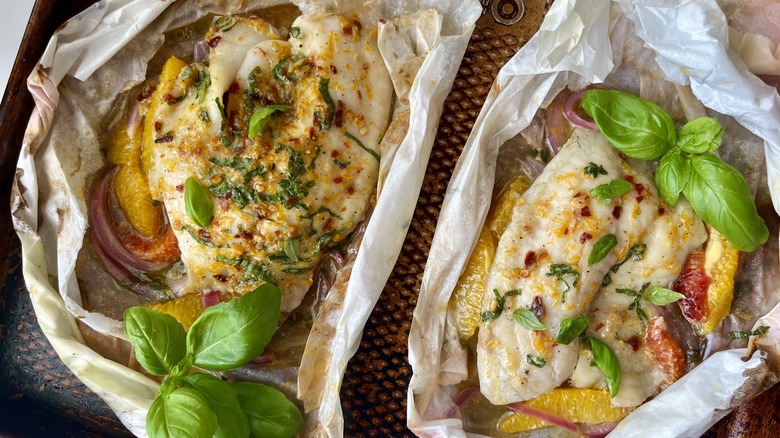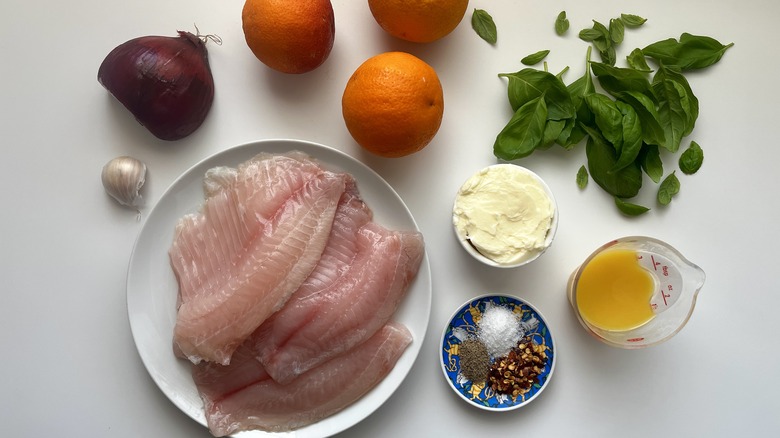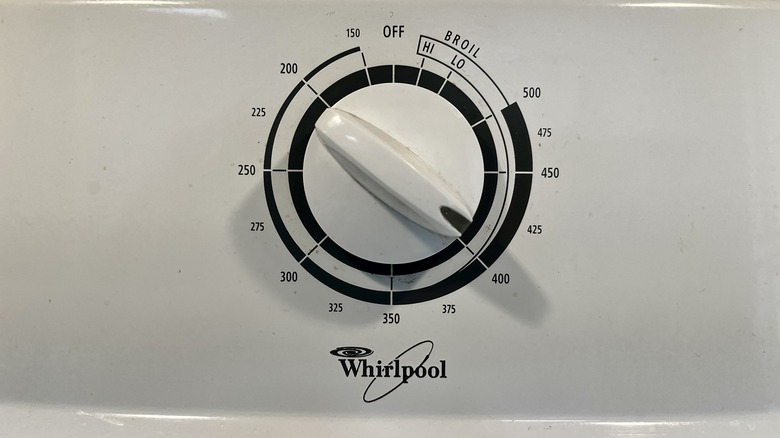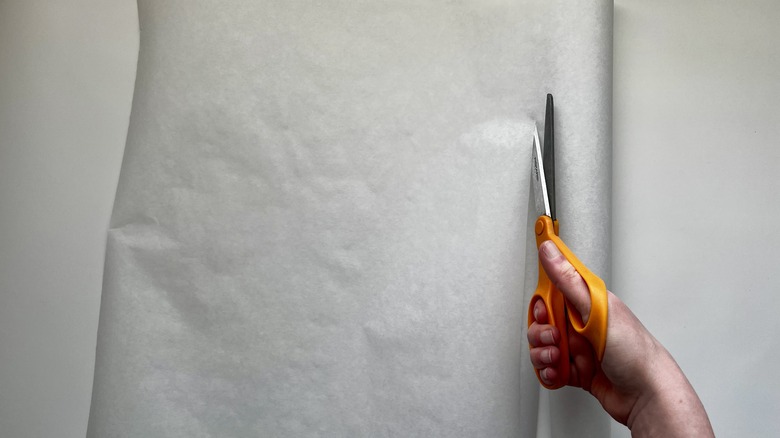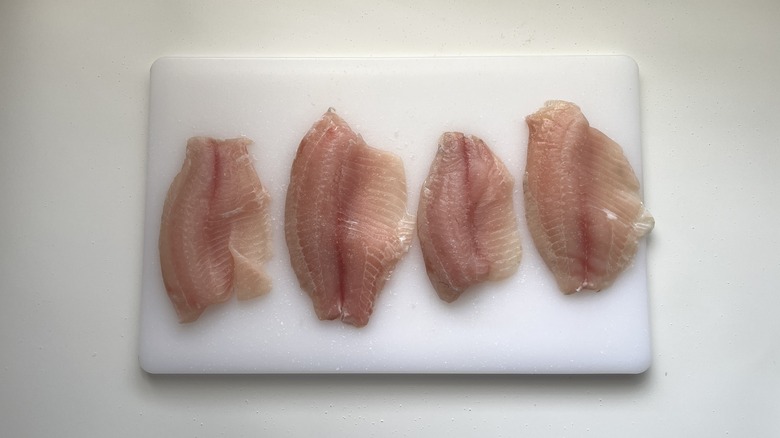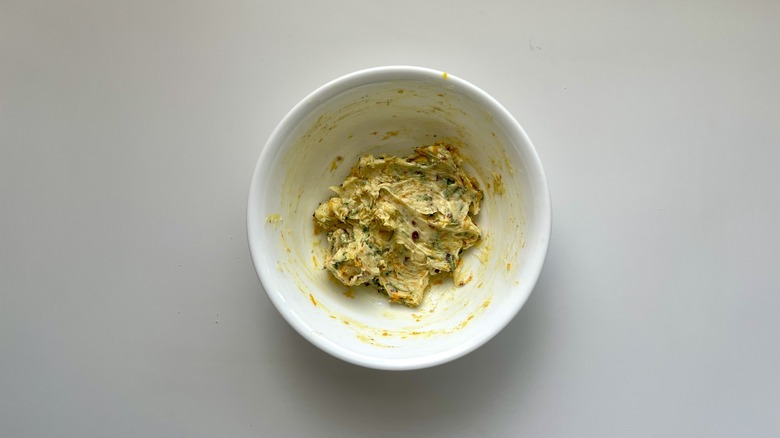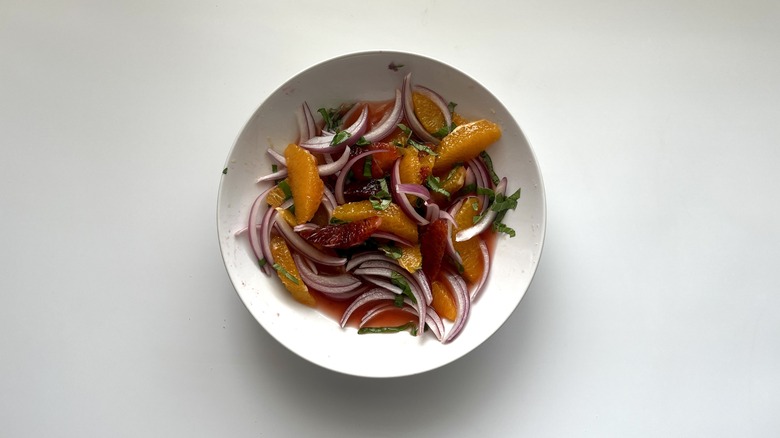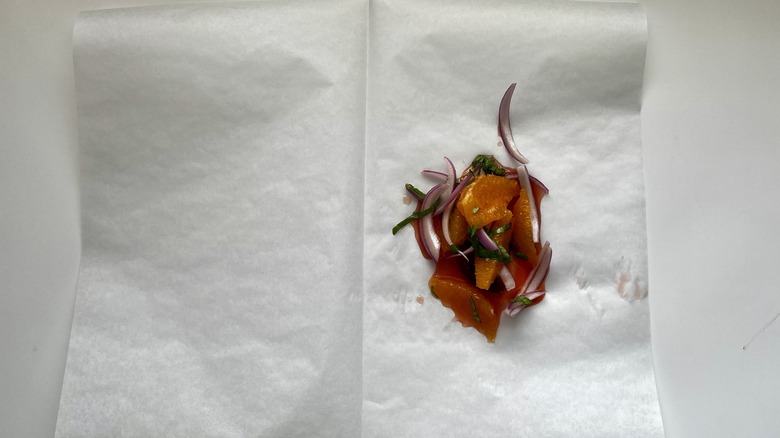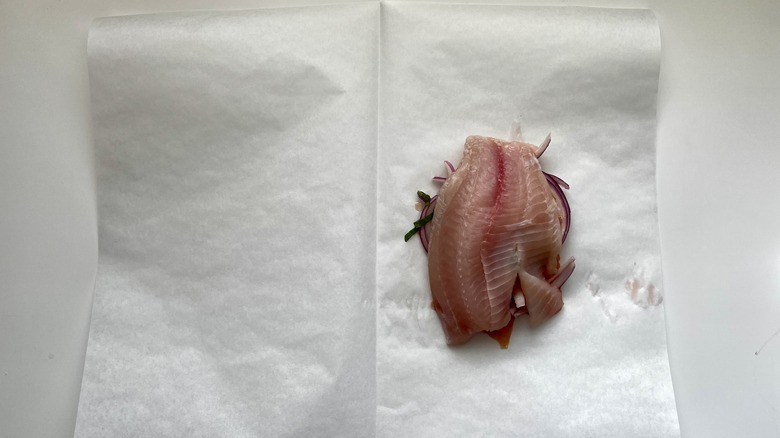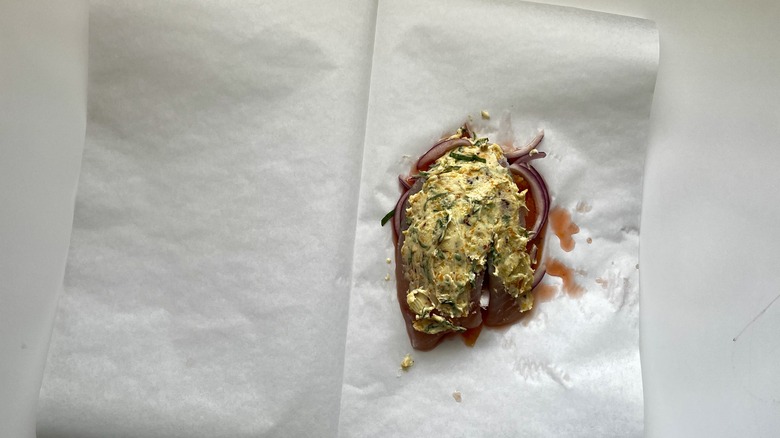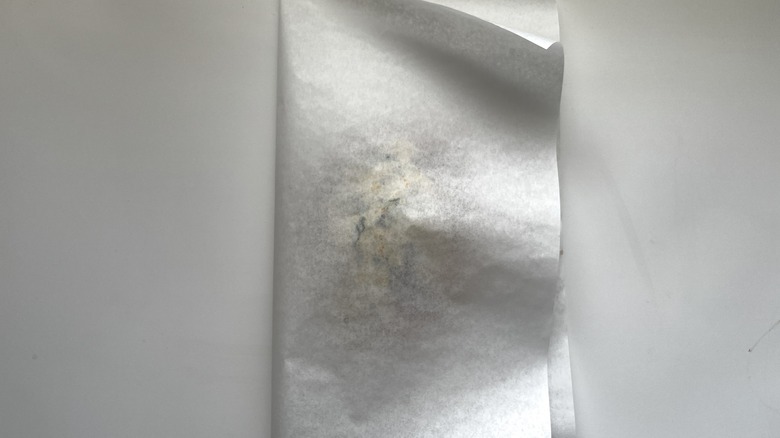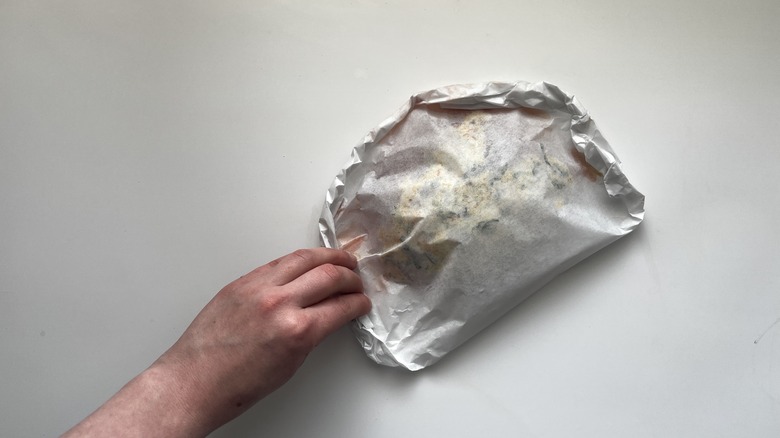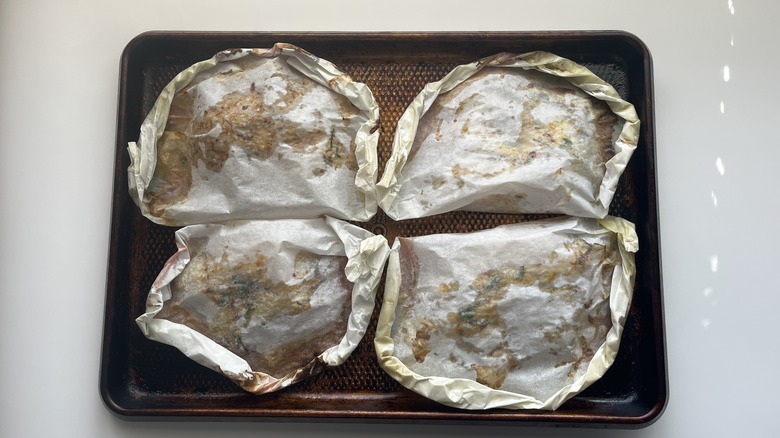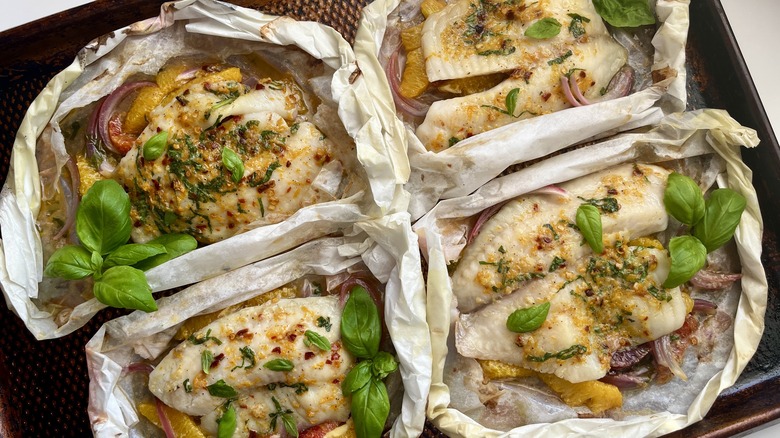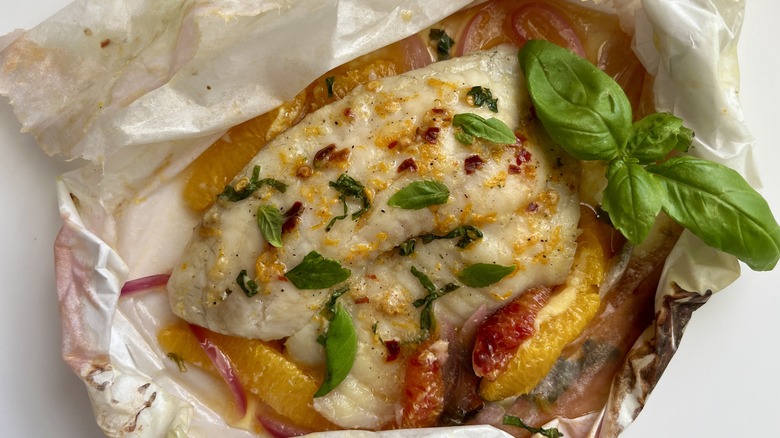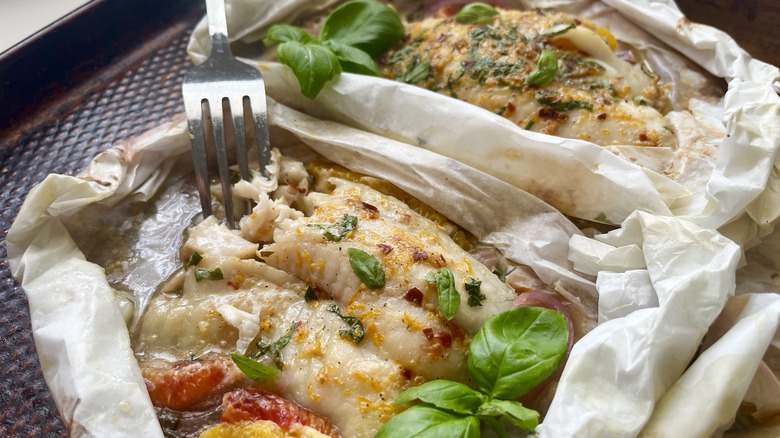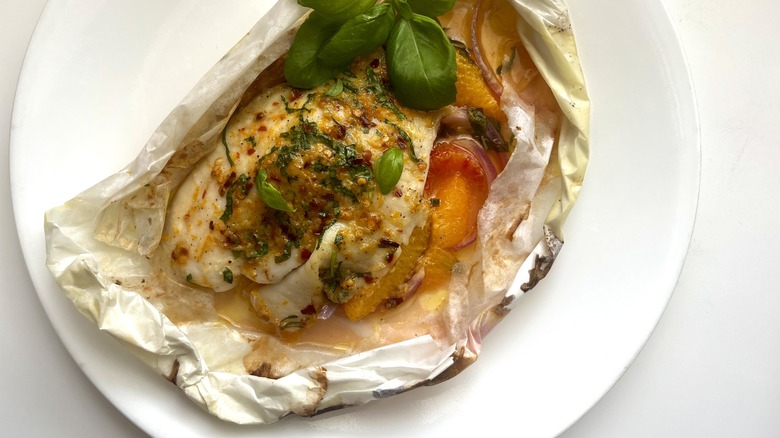Orange And Basil Tilapia Baked In Parchment Recipe
There are several different ways to cook fish — you could fry it, grill it, steam it, or even sous vide it if you're feeling fancy. One of the most tried and true methods of cooking fish is baking it, which ensures an even cook throughout the entire fillet and allows you to do something else while the oven does all the work. This orange and basil tilapia, brought to us by recipe developer Tess Le Moing, does indeed use the baking method to achieve perfectly flaky fish, but it also takes things a step further by cooking the tilapia fillets in parchment paper packets.
You may be wondering — what is the benefit of cooking fish in parchment paper? "Cooked fish in parchment, or 'en papillote,' is gently steamed in the packet, so it stays moist while it's infused with the flavors of the orange and basil," Le Moing explains, which means that you don't have to worry about tough or overcooked fish.
Parchment baking aside, Le Moing highlights just how easy this seafood dish — which features tilapia as the base, an orange compound butter, and an orange salsa — is to put together, noting that it's healthy, aesthetically pleasing, and most importantly, delicious. "Tilapia is a mild fish that allows the delicate flavors of fresh orange and basil to shine through," she says, adding that the orange-scented butter on top of each fillet adds the perfect rich, citrusy final touch.
Gather the ingredients for orange and basil tilapia baked in parchment
To kick off this fresh recipe, you'll need four skinless tilapia fillets, with the bones removed, and a little bit of salt for seasoning. For the orange compound butter, be sure to have softened butter, fresh basil leaves, orange zest, grated garlic, red pepper flakes, salt, and pepper on hand. Finally, for the orange salsa, you'll need cara cara navel oranges, a small red onion, more fresh basil, fresh orange juice, and a little more salt. You may also want some extra basil on hand to garnish the final dish.
Step 1: Preheat the oven
Preheat oven to 400 F.
Step 2: Cut the parchment paper sheets
Cut 4 (14-inch-long) pieces of parchment paper.
Step 3: Season the tilapia fillets
Prep the fish: Place tilapia on a cutting board, season on both sides with salt, and set aside.
Step 4: Make the compound butter
Make the orange butter: Combine softened butter, basil, orange zest, garlic, crushed red pepper, salt, and black pepper in a small bowl.
Step 5: Prep the salsa
Make the orange salsa: In another bowl, combine the orange segments, red onion, basil, orange juice, and salt.
Step 6: Add salsa to the parchment paper
Divide orange salsa among the parchment sheets, placing it on one half of the paper.
Step 7: Place the tilapia on top
Place the fish on top of the salsa.
Step 8: Spread orange butter on top
Spread about 1 tablespoon orange butter onto each fillet.
Step 9: Fold over the parchment paper
Fold the other side of the parchment over the fish.
Step 10: Seal the parchment pouches
Starting at one end of the paper, tightly fold the edges, continuing along the perimeter until well sealed.
Step 11: Bake the fish
Transfer fish pouches to a rimmed baking sheet and bake for 10 minutes.
Step 12: Garnish with basil, and serve
Open the packets, garnish with fresh basil, and serve immediately.
Can you prepare baked fish in parchment paper ahead of time?
This tilapia already offers a certain convenience since it's a one-pan dish, and there's even more convenience to be found in the fact that you can make elements of the recipe in advance. "Make the salsa and compound butter the day before, and assemble the packets the next day," Le Moing tells us as a prep trick. Both the butter and salsa will keep well in the fridge, so when it comes time to bake the fish, you can pull them out and proceed with the recipe as written.
Another option is to prep the entire parchment pouches in advance, so all you need to do stick them in the oven and serve the day of. While Le Moing says it's fine to refrigerate your packets until you're ready to bake, she does warn not to prep them too far in advance; it's best to make these only 24 hours ahead of time to ensure that everything stays as fresh and flavorful as possible.
How do you know when fish is done baking?
It's not always easy to tell when fish is done baking, which can easily lead to overcooked fillets with a tough texture. Luckily, Le Moing has some tips to ensure that your fish stays supple and moist, and, best of all, you'll be able to easily tell if the protein is cooked both with and without a meat thermometer.
"Insert a thermometer into the thickest part of the fish fillet to get an accurate reading," Le Moing advises for the meat thermometer method, noting that the temperature you typically want for fish is about 145 F. If the fish isn't quite there yet, simply return it to the oven and re-temp in a few minutes.
No meat thermometer, no problem — you can also check tilapia's doneness by testing its flakiness. "Gently open one of the parchment packets and test a small portion of the fish with a fork. If it flakes easily and the flesh is opaque, it's done," says Le Moing. "If it still appears translucent or feels rubbery, it needs more time to cook."
How do you serve baked fish in parchment paper?
This orange and basil tilapia naturally makes for a great dinner option, with its bright and herbaceous flavors working well in just about any scenario. "It's versatile enough to be served on various occasions, from casual gatherings to formal dinners, making it a go-to recipe for any cook looking to impress," Le Moing tells us. Think family dinners, date nights, or dinner parties. And when it comes to plating, you can transfer the opened parchment boats right to plates — not only is it convenient, but it means that you can retain all of the salsa and citrusy juices without making a mess.
As for what to serve with the fish, you could double down on the orange with a charred citrus salad, or keep things simple with roasted potatoes or vegetables like corn, asparagus, or carrots. Or, you can follow Le Moing's ideal pairing approach: "My favorite way to serve this is with warm grains like rice, couscous, or quinoa to soak up all the flavorful juices."
Orange and Basil Tilapia Baked in Parchment Recipe
Baking these light, fresh, and fragrant tilapia fillets in parchment paper packets, or en papillote, is an easy way to keep the fish moist and perfectly tender.
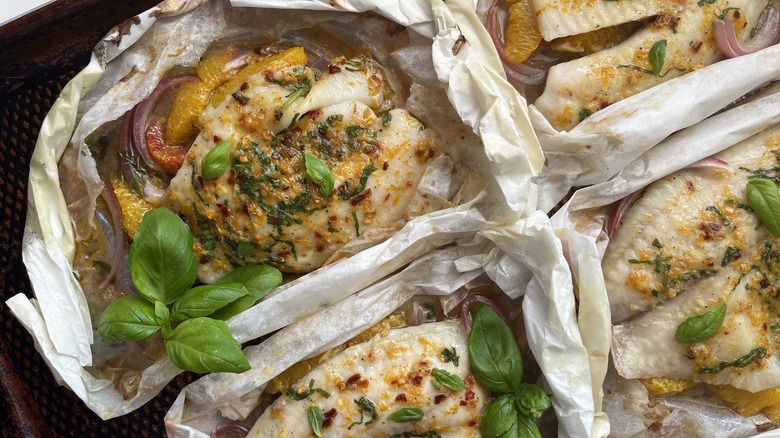
Ingredients
- For the fish
- 4 skinless tilapia fillets (about 5-6 ounces each), bones removed
- 1 teaspoon kosher salt
- Fresh basil leaves, for garnish
- For the orange butter
- 7 tablespoons butter, softened
- 6 fresh basil leaves, julienned
- Zest of 1 orange
- 1 teaspoon grated garlic
- ½ teaspoon crushed red pepper flakes
- ½ teaspoon salt
- ¼ teaspoon ground black pepper
- For the orange salsa
- 3 cara cara navel oranges, supremed
- ½ small red onion, thinly sliced
- 10 fresh basil leaves, julienned
- 3 tablespoons fresh orange juice
- ½ teaspoon salt
Directions
- Preheat oven to 400 F.
- Cut 4 (14-inch-long) pieces of parchment paper.
- Prep the fish: Place tilapia on a cutting board, season on both sides with salt, and set aside.
- Make the orange butter: Combine softened butter, basil, orange zest, garlic, crushed red pepper, salt, and black pepper in a small bowl.
- Make the orange salsa: In another bowl, combine the orange segments, red onion, basil, orange juice, and salt.
- Divide orange salsa among the parchment sheets, placing it on one half of the paper.
- Place the fish on top of the salsa.
- Spread about 1 tablespoon orange butter onto each fillet.
- Fold the other side of the parchment over the fish.
- Starting at one end of the paper, tightly fold the edges, continuing along the perimeter until well sealed.
- Transfer fish pouches to a rimmed baking sheet and bake for 10 minutes.
- Open the packets, garnish with fresh basil, and serve immediately.
Nutrition
| Calories per Serving | 406 |
| Total Fat | 23.1 g |
| Saturated Fat | 13.5 g |
| Trans Fat | 0.0 g |
| Cholesterol | 131.4 mg |
| Total Carbohydrates | 19.5 g |
| Dietary Fiber | 3.4 g |
| Total Sugars | 13.4 g |
| Sodium | 795.2 mg |
| Protein | 33.1 g |
